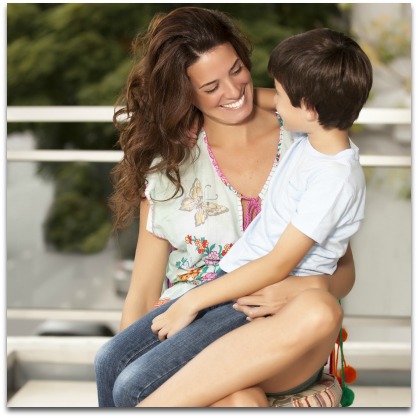 When I was a sophomore in high school, my parents sat the family down in the living room, opened up an enormous binder and asked my younger brother and me to pick a sister, any sister, from any country around the world.
When I was a sophomore in high school, my parents sat the family down in the living room, opened up an enormous binder and asked my younger brother and me to pick a sister, any sister, from any country around the world.
We chose an eighteen-year-old, trumpet-playing, tall and strong-minded Finnish student who did, indeed, become a real sister to me over the course of the following year.
My parents had made rumblings in the past about hosting a foreign exchange student. We lived in a tiny, rural town in Central California, so they saw the exchange experience as a double-blessing: My parents could share the wealth of our small-town lives and the beauty of our diverse state while culturally enriching their own children’s lives. We had previously hosted a German teacher for a summer, and my brother’s baseball team had provided temporary housing for players from Russia — the USSR at that time. We were no strangers to strangers in our home.
But when the day finally came to choose the exchange student, I was nervous about the change. My life was filled with academics, sports and other extracurriculars, and my parents both had busy jobs in addition to being key participants in their children’s activities.
This experience was going to put me outside my comfort zone, and I wasn’t sure I would like it. Would there be enough room for another sister? Would my parents have enough love to go around? What would we gain by shaking up our seemingly comfortable lives?
As it turned out, quite a lot! While that year certainly came with ups and downs—as they do in any family—the lifelong friendship, the bond of sisterhood and the cultural experience I gained from having Karo in my life outshone all the extra squabbles over the shared curling iron.
It was such a worthwhile experience, that here we are, over 30 years later, preparing to choose another sister. Only this time, it’s my own family—my husband, myself and our three daughters. And this time, there will be no binder, no leafing through pages of possibilities, since we have already chosen our sister-for-a-year: Karo’s daughter from Finland.
We were thrilled when we heard her teenage daughter was searching for a host family, and we knew right away that our family would be an ideal fit.
What we didn’t bank on was that not all of our family members would immediately jump at the idea. One of our daughters put up a wall of “no” and initially refused to discuss the opportunity. After a few weeks of tippy-toeing around the topic, we discovered the reason she was digging in her heels: She was scared of change.
Past parenting experience with this daughter told us that while she was typically resistant to change, she also tended to be very logical, and often she just needed time to think things through. And that is precisely what we allowed her to do as our family discussed how this experience would affect all of us.
There is no shortage of “sisters” in our household (ask my husband!), but we decided to embark on this journey because we hope bringing another sister into the family will enrich our daughters’ lives.
And often, the kids who are the most resistant to change are the ones who need the most help to move beyond their comfort zone. Stability and safety are good for a child’s development; stagnancy or stubbornness, however, can sometimes do more harm than help.
To use a metaphor from nature: When you plant a new tree, you use support stakes to prevent the trunk from breaking, but eventually you remove those stakes so the tree can blow and flex with the wind. This not only helps the tree grow stronger, but if the stakes are left in the ground too long, the rigidity can damage the tree.
Likewise, teaching kids to embrace change can make them more resilient and stronger in the future.
As I write this, we are preparing for our first host family interview, so we’ve come a long way in our decision to welcome someone new into our home. I want to share some strategies we’ve used with our daughter to move her from a wall of “no” to a doorway of promise.
You can apply these strategies to any new experiences: bringing home an elderly relative, transitioning from one house to another, moving out of state or to a new country, welcoming home a family member from the military or abroad, embracing a new sister or brother—whether they are brought home in a baby blanket or chosen from a binder full of possibilities.
#1: Consider Your Child’s Personality
 Our three daughters have much in common: They are good students, they are thoughtful and kind, they have good heads on their shoulders and much more. We count ourselves fortunate, but we also recognize they are human and complex.
Our three daughters have much in common: They are good students, they are thoughtful and kind, they have good heads on their shoulders and much more. We count ourselves fortunate, but we also recognize they are human and complex.
We try not to pigeonhole them, but, undeniably, they approach challenge and change from different perspectives. One daughter goes with the flow pretty much all the time, which is wonderful, except that she occasionally needs a motivating push; one daughter is open-minded and listens to others’ opinions before settling on her own, which is great but can make her prone to indecision; and one daughter meets nearly everything with stubbornness first but is also very confident in her own abilities. Each possesses two sides of the same coin, so to speak.
Because our three girls tackle life from different angles, our parenting strategies must be different with each to mold to their needs.
When it came time to discuss hosting a foreign exchange student, we were met with wide-eyed enthusiasm from one daughter, but we had to remind her that this would involve change—to her bedroom, her bathroom, our family’s travel schedule and pretty much her whole life. She hadn’t thought through all the ways the experience would impact her, but once we answered her questions, she was still keen on the idea.
For our resistant daughter, we knew that early opposition was fairly commonplace for her. So, we brought it up once, dealt with the early objection and let it rest for a while before revisiting the topic. This strategy had worked in the past, and it did this time too.
When helping a child move beyond his or her comfort zone, it’s important to parent them according to their personalities.
#2: Leave Space for Thought
 Big changes require deep thinking, and kids might need help with that.
Big changes require deep thinking, and kids might need help with that.
You can teach your child to leave space for thought with three simple strategies: remove the “brain-clutter” or noise, create safe zones in your house and allow chunks of time for reflection.
The older I get, the less “brain-clutter” I can tolerate. I used to be able to do about five things at once: stir a pot of spaghetti sauce, help my youngest with math homework, listen for the beep of the washing machine, check my phone for text messages and sing out loud to my teenager’s blaring music to boot.
Not anymore. So when something weightier needs to be discussed, like counseling my daughter about a friend’s behavior at school or coping with an ailing grandparent, I put all distractions on pause.
I’m sure my daughters would say that my inability to multitask is due to my descent into middle-age, but I frequently see the same problem in them too.
I encourage them to cut out the “brain-clutter” when they need to think deeply. Music is wonderful…but not if the lyrics distract from getting homework done. Phones are fantastic tools… but can become diversionary toys. Conversations about life-changing events are necessary…but should be done face-to-face with no other distractions.
Similarly, you should try to create spaces in your home where people can be alone with their thoughts. Each of our daughters has her own room, but that perk will disappear once we welcome our exchange student. We have assured our girls that even though each person will have to give up some personal space, we will still create privacy zones.
This might mean relinquishing our own master bedroom or setting a daughter up by herself on the patio with headphones and snacks. If the change you are going through in your family involves bringing another person into your household, it’s especially important to create places where kids can get away.
Finally, recognize that time is a great healer. With our daughter who was reluctant about the exchange student experience, we knew that time would do us all some good. If a parent is returning from time away or there’s another change in your family, give a child time to mull this over. Do not spring a big decision on kids; instead, talk about it in small doses.
#3: Share Your Worries and Windfalls with Your Child
 What if our kids don’t get along with the exchange student? What if she gets injured while she’s living with us? What kinds of experiences or vacations do we want to experience with her, and will there be enough time and money for all of that? What if I don’t “mother” her the way her own mother does?
What if our kids don’t get along with the exchange student? What if she gets injured while she’s living with us? What kinds of experiences or vacations do we want to experience with her, and will there be enough time and money for all of that? What if I don’t “mother” her the way her own mother does?
I have fears about change, too. So does my husband. And we share these worries with our kids all the time. We share with our kids if a relative is sick or if we simply can’t take on another activity that month because we’re trying to stay within budget.
I have always subscribed to the mantra that our car is a safe place for conversation. My three girls know that if something bad happened at school that day, they can save it for the car and know there will be a chance to talk about it.
My family actually has a name for this, and we call it our “pits and cherries” of the day. What were our pits, or the things that made us angry or scared us that day? What were our cherries, or the great things that happened?
It’s that simple. You’d be amazed at how comforting it is to share your worries and windfalls, but be warned that it can result in some pretty deep car-talks—or some serious giggles.
By sharing our own “pits and cherries” with our kids, they see that it’s perfectly fine to have fears, and that sometimes those fears are overshadowed by the good that can come from embracing adversity.
#4: Remind Your Child of His or Her Value
 This is a no-brainer: Remind your kids on a regular basis—and especially during times of change in their lives—that they are valued and important.
This is a no-brainer: Remind your kids on a regular basis—and especially during times of change in their lives—that they are valued and important.
During periods of conflict in our household, it’s easy to get caught in a rut of pessimism. Dwelling on the negativity of the problem rather than on the value of the people leads us down a thorny path more often than not.
Instead, if you face the challenge of helping your child move beyond his comfort zone, remember to back up and reflect on why each person involved matters. Perhaps one child is fiercely independent, or maybe one of them is great at chores. Say this out loud, often, and repeat.
This past summer, six of our oldest daughter’s friends moved away or transferred to out-of-town schools. She was saddened by this and still greatly misses the close friends she grew up with, but instead of wallowing in sadness, we reminded her that she, too, is a fantastic friend. This has opened her up to other relationships, inspired her to move out of her comfort zone and join new sports teams and clubs and moved her to reevaluate her own identity as an independent young woman.
Our daughter has learned to “make new friends but keep the old; one is silver and the other gold.” And perhaps reminding her that she is the diamond of the bunch—strong, resilient, shining—is the best way to help her cope with this big change.
#5: Remind Your Child of the Future Value of This Experience
 Kids have a difficult time thinking much beyond their next meal. Younger kids might not even be able to grasp the concept of “tomorrow.” But you can help your kids move from one experience to the other by focusing on future benefits.
Kids have a difficult time thinking much beyond their next meal. Younger kids might not even be able to grasp the concept of “tomorrow.” But you can help your kids move from one experience to the other by focusing on future benefits.
We have one daughter in high school, one in middle school and one in her last year of elementary school. This makes for a whole lot of chauffeuring every day, but more importantly, they are all at various stages of cognitive development.
Thinking ahead is not really the strong suit of our youngest. However, even at her age, she understands what it means to “look forward to” something, and we’ve capitalized on that to help her become forward-thinking. For instance, we have made it a point to involve her in discussions about our vacations—even those that are a year or more away. We ask for her input on places to visit and things to do.
And when we moved from one house to another a few years ago, she was initially devastated at the thought of leaving the only house she’d ever known. To make the transition easier, we went on long walks from the old house to the new one—something we could do because we moved only a mile away!
But to her, it was the longest distance in the world, so getting her to think about the long-term benefits was essential. We walked by the creek that backed up to our new house and let her traipse around collecting rocks and shells. Whenever we visited the community swimming pool, we reminded her that our new home would have its own pool. When she fought with her sisters in their shared bedroom, we asked her how she might organize her own personal bedroom at the new house.
Evaluating an experience and predicting how it will impact you in the future is a higher-order thinking skill, so it might take some nudging from you to help younger kids understand, but it’s a great way to help kids think beyond today and into their future.
#6: Have Fun with Preparation
 Make change fun for your kids! Find creative ways to inspire your kids to move beyond their comfort zone by looking on the bright side.
Make change fun for your kids! Find creative ways to inspire your kids to move beyond their comfort zone by looking on the bright side.
- Locate others in your friend circle or neighborhood who have had similar experiences. Perhaps a family moved to your town recently, and you can set up a playdate—both for the benefit of the kids but also so you can ask the parent how they coped with the change.
- Books and movies can confirm your child’s worries but also show him or her the positives. Ask your local librarian for suggestions or plug in an internet search term like “helping kids cope with a new home.”
- Let kids get creative in how they welcome the changes in their lives. Our daughters will all be moving from one bedroom to another when our foreign exchange student arrives, so we have told them they will get to decorate their new rooms. Just that prospect alone is quite the motivator! But we have also told them to come up with their favorite local trips so we can share those experiences with our foreign exchange student.
- Journaling and painting are two great ways to help a kid work through a life challenge. If you are welcoming a new baby, family member or even a “stranger,” as our family is, have kids create posters or photo albums to share.
#7: Compromise and Relinquish Some Control
 What ultimately helped our hesitant daughter realize that hosting an exchange student would be a positive experience was actually less about giving in and more about giving up—some control, that is.
What ultimately helped our hesitant daughter realize that hosting an exchange student would be a positive experience was actually less about giving in and more about giving up—some control, that is.
We realized that her resistance stemmed from her inability to control the situation, so giving up a little bit of control in order to gain a child’s trust and buy-in are important.
First, we asked about her specific concerns. As expected of an adolescent girl, privacy was a major issue. If she shared a bedroom with someone, how would she find any privacy? Since she is the cleanest of the three girls, how could she maintain order in a shared room?
So, we offered some small compromises, such as allowing this daughter her own room or allowing her to choose a few of the family trips throughout the year. Compromise can go a long way in helping a child feel like they have some control over their lives.
We have also assured our daughters that compromise is a two-way street, and it’s an ongoing endeavor as well. When we finally become a family of six, we will need to share, make some sacrifices and learn to give up a bit of control for the benefit of the group.
The 2-minute Action Plan for Fine Parents
Helping kids move beyond their comfort zone is character-building and necessary for their future development into resilient, strong adults. Ask yourself these questions to see if you’re ready to help them take the leap from comfort to beyond:
- When it comes to a major change, do you talk more or listen more to your child? Can you turn that pattern around and do more listening?
- What are three traits you value most about your child, and how can these traits help him or her during this time of transition?
- What are three things you are willing to compromise on or change in order to move beyond your comfort zone? How can you role-model this for your child?
The Ongoing Action Plan for Fine Parents
Different age groups have varying needs when it comes to moving beyond what is comfortable. Here are some ideas:
For Littles: Give Them Guidance
Younger, elementary-aged children need support and guidance. They need reassurance that everything will be fine even if they are going through a major change. Make time for one-on-one activities and encourage them to talk about or use art to explore their emotions.
For Pre-teens: Give Them Privacy and Space
Pre-teens are already struggling to find their own identities, and when major changes occur, they might resist. Give them their own safe zones, privacy and a secure, loving environment so that when they are ready to talk about their feelings, they know where to find you.
For Teenagers: Give Them Connections
Teenagers want to belong. Express how much you value their positive characteristics, and find easy ways for them to connect with you. You might consider a shared journal that you pass back and forth each evening so they don’t feel pressured to express themselves in person. Make sure they get ample time with their friends while your family is going through a transition period, but also encourage connections within the family.
Someone is trying to find a way to help a child get out of his comfort zone, and we recently moved and this is one of those ways. My advice before “taking the child out of the comfort zone”: Prepare for the Challenge: Once your child has chosen his or her own challenge, ease them into tackling it.
Thanks so much for your comment, Dheeraj!
The blog is really brilliant and the information is very useful. Thank you for sharing.